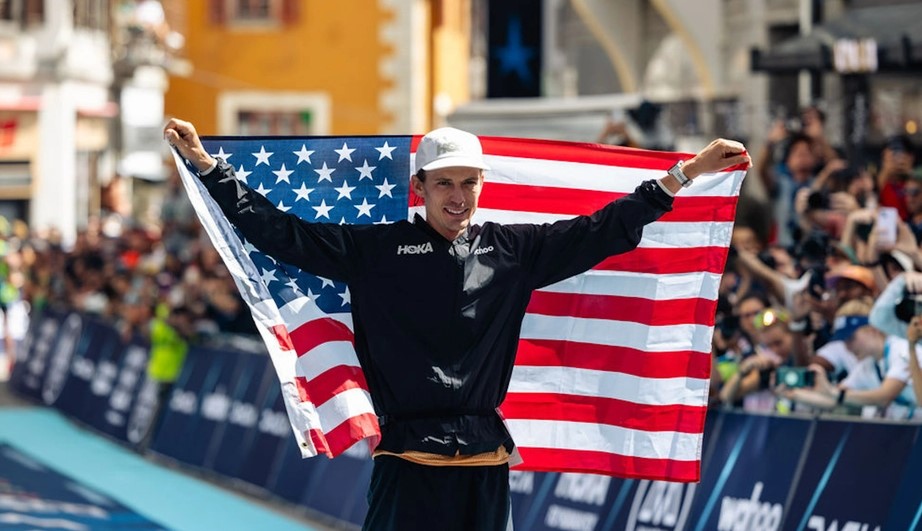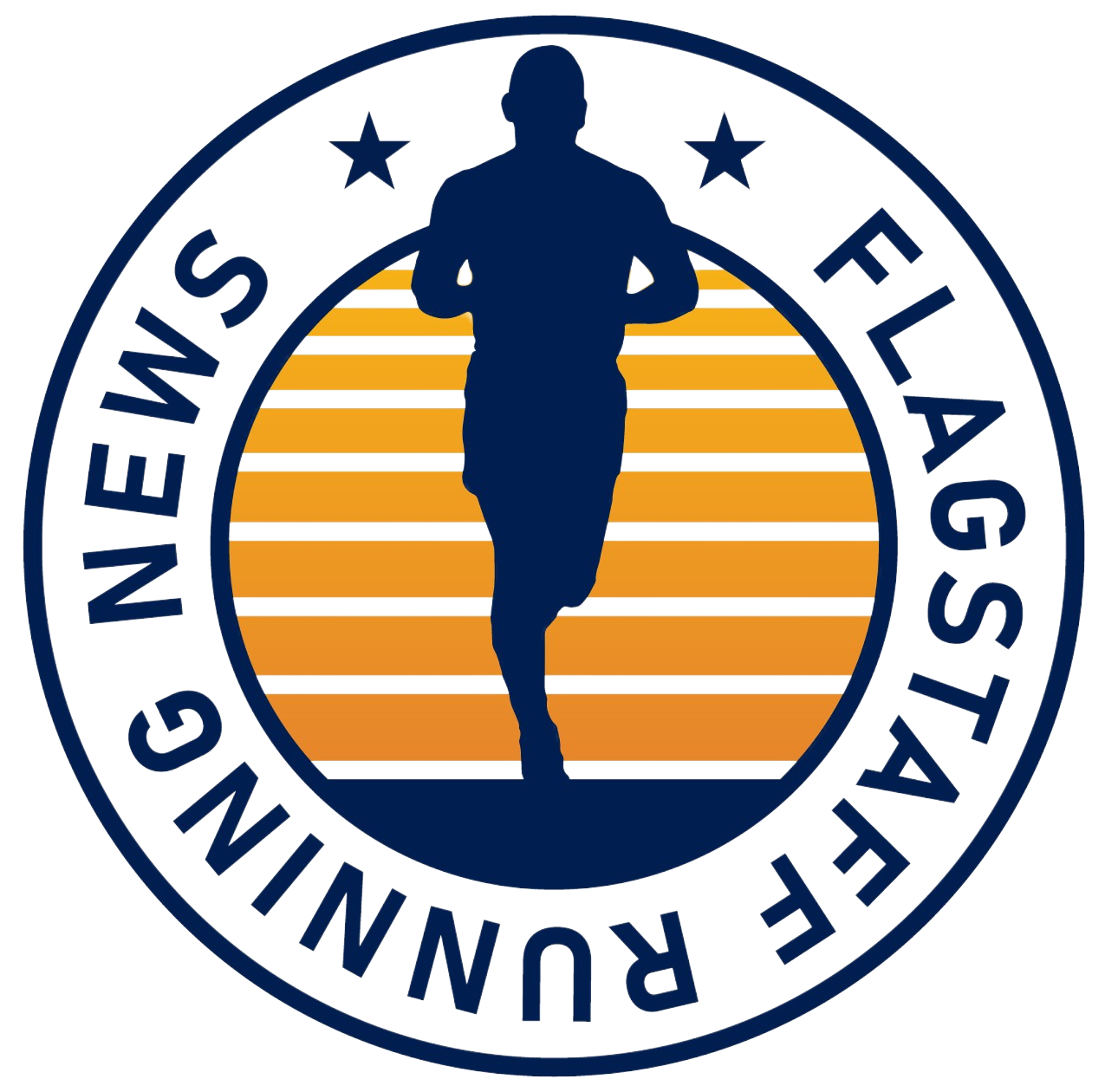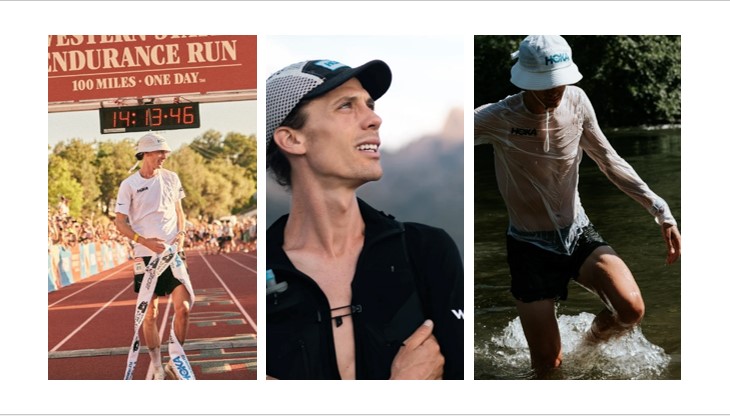Jim Walmsley coasted in and parked his e-bike outside the Kickstand Kafe, unbuckled his helmet, tugged on his Hoka cap, walked in the door, shook my hand, and stood in line to purchase a Coke.
Hoving into view behind him was a middle-aged man decked out in your typical Flagstaffian running garb. He made a beeline to Walmsley and me, waiting to pay the barista. The man started chatting up Walmsley. Oh no, I thought, cringing internally, this must be another ultra acolyte wanting to talk running.
“Is that your e-bike out there?” the guy asked.
“Yeah,” Walmsley said, smiling.
“Cool. Hey, I organize mountain bike and trail running events. You do that?”
Now, I was outwardly cringing.
Worse, perhaps, than somebody recognizing Walmsley in Flagstaff and wanting to bother him was someone who did not recognize perhaps the world’s best ultrarunner, who won the Western States 100 Mile Endurance Run for the fourth time in late June and will defend his UTMB Mont Blanc title in August.
But Walmsley, ever the nice guy, didn’t miss a beat.
“Yeah, I do a little of both,” he said, with nary a trace of sarcasm or condescension.
“Cool. See ya around,” the guy said, then made his own order up front.
Minutes later, as we settled in at a table to talk about Walmsley’s bid to do the “double” – winning Western States and UTMB in the same year – I asked Walmsley if he was mildly amused or annoyed by the counter encounter.
After all, his profile has never been higher. He, perhaps, is Hoka’s most famous distance-running athlete and one of the shoe company’s highest paid. But the 34-year-old, who now splits time between Flagstaff and the alpine valley of Areches Beaufort near the UTMB course in France, actually seemed entirely unfazed.
“It’s fine,” is all Walmsley said, maybe hoping to move the conversation forward.
But I, at the risk of annoying him, pressed just a little longer. The encounter seemed at once atypical and so apropos. In Europe, Walmsley is approaching the popularity of ultra legend Killian Jornet. In his village in France, albeit only with a population of 300, Walmsley is known everywhere and is often recognized all over the country, especially after becoming the first American male to win the 106-mile UTMB in Chamonix last August.
I asked him to explain the popularity of ultra/mountain running in his adopted (well, for about half the year) country.
His expression lit up. He put the Coke bottle down and talked excitedly.
“France, as a country, is embracing (ultra running) more and more,” he said. “They love sport and individual sport and they have different priorities in sports in general. They really like trail running. They are probably the biggest per capita trail running country in the world. In the states, it’s less known among normal people, whereas in France many, many normal people know who the stars are in trail running. It’s looked at as a true world-class sport, something that they love culturally.
“For U.S. ultra running, Western States is looked at as the American Super Bowl compared to grassroots ultras. It’s a big production and show, comparatively. It’s got the best qualifying system in the U.S. Western States is only one tenth the size of UTMB. But the amount of fans? One tenth would be generous toward Western States. Last year was really electric at UTMB, so many people cheering. You’re talking the closest thing to the Tour of Flanders and Tour de France hilltop stages. It was truly deafening noise as you were running through the tunnel of people. And it can be for a couple of kilometers…”
He paused, took a sip, then concluded: “It’s insane.”
Make no mistake, Walmsley has not been transformed into a Francophile and doesn’t even consider himself an expatriate. He grew up in Phoenix, still has his house in Flagstaff, which he and wife Jessica Brazeau still consider home, and they love escaping to Silverton, Colo., for extended trips whenever possible.
Still, Walmsley seems smitten with France, perhaps because it took him two years of living and training there to achieve his breakthrough of finally winning UTMB after several tries.
“In the states, (ultrarunning) is less known among normal people, whereas in France many, many normal people know who the stars are in trail running. It’s looked at as a true world-class sport, something that they love culturally.”
Jim Walmsley
To call Areches Beaufort remote is an understatement. He said most of the homes in that village of 300 are owned by “a few families,” and the next nearest village boasts only 1,000 residents. The town of Albertville, where the couple does its primary grocery shopping, is a 30-mile drive, “but it’s a really winding, twisty road, like driving down Oak Creek Canyon from here.”
But it’s ground zero for mountain-running training, so specific to Mont Blanc preparation.
Walmsley forever seeks out big vert training; France gives him that in spades.
“From the house we were living in, you can walk out the door and there are probably four different mountains and directions you can hit in over a vertical kilometer of elevation gain in less than five miles,” he said. “It’s truly in the mountain.”

He paused, reached into his pocket for his smart phone.
“You want to see the heat map (on Strava)?” he asked.
Walmsley swiped a couple of times and up popped his Stava account. He spread his thumb and forefinger over the area to zoom in on his training routes.
“Now, this is my heat map for Flagstaff,” he said, showing a criss-crossing of routes in the San Francisco Peaks and Mount Elden. “It’s nice. I do a lot of my training around Elden, the steeper section areas.”
He flicked the screen twice.
“I got a lot on the heat map popping up in the San Juans (of Colorado), too,” he said. “That’s nice.”
Now, Walmsley flicked several times, and the screen advanced across an expansive blue ocean and settled on rural France.
Suddenly, the screen lit up with scores of routes intersecting, bisecting, looping over one another. It looked like the back of an octogenarian’s hand, routes running like veins all over the place. He pointed to a long loop to the east of where most of the activity is settled.
“That hard loop there is the UTMB loop (up in Chamonix, 80 kilometers north),” he explained. “That’s two hours away, driving-wise. You can see the spider webs (of trails), how it’s all interconnected. It’s really a crazy, amazing place to train. It’s a valley that dead ends and then they call it a cirque, you know, a bowl.
“The highest mountain is 8,800 feet, but you can go up and over the other side and connect with other places. It’s a really playful mountain range with nice ridges. You can connect with entire ridgelines.”
Walmsley seemed so enthused talking about the French trails that I, hesitantly, asked him if, having spent the better part of a decade running in Flagstaff and the Grand Canyon, he was bored running here.
He gave a curt nod, then explained.
“Yeah, I’d say so,” he said. “I’ve done trails in Flagstaff literally over 100 times. With the Grand Canyon, I get bored with how crowded it is. Over the years, I’ve gotten more polite. My downhill times in the canyon are not as fast as they used to be, because I pause and stop and walk around people nowadays. I try to be polite.
“But the Grand Canyon is 14 percent (grade). It’s not very steep. There (in France), it’s so steep. Many, many trails are over 20 percent. Where here, we probably have, well, I can think of only Private Reserve, Elden Lookout Trail, Blue Dot (the social trail). There used to be some really short Dry Lake (Hills) ones that used to get close to 20 percent. You have to practice steep stuff because that will make you last longer and longer and prepare you for European races.”
“I don’t think I can build the right skills (for UTMB) in Flagstaff. We’re not in the mountains, and I need to train in the mountains for UTMB to get strong enough.”
Jim Walmsley
Moving to France, then, was the correct call if Walmsley wanted to beat the best mountain runners Europe has to offer.
Training in a flatter, but still high-elevation Flagstaff helps in events such as Western States, which Walmsley proved again by winning two weeks ago in the second fastest time ever. But Flagstaff lacks the steep terrain he needs.
Would he have won UTMB last year had he not trained in the Alps?
“I don’t think I can build the right skills (for that race) in Flagstaff,” he said. “We’re not in the mountains, and I need to train in the mountains for UTMB to get strong enough. Coming from more of a running background, I needed to work more on steep, steep trails. It was working on my weaker points of the race.
“I’ve gotten more efficient and comfortable with my pack system and poles. I used to kind of downplay trying to pick that stuff up and have it feel normal. But in reality, I’d say it’s more an extension of a system I’m really familiar with. Training there and knowing runners there helped me adapt to (the) specific (race conditions).”
Back in his early days in Flagstaff, circa 2016, Walmsley was the ring leader of a group of young, footloose trail runners who called themselves the Coconino Cowboys. The group eventually dissolved, and Walmsley now mostly trains as alone wolf in Flagstaff and Colorado.
But, in France, Walmsley found a few training partners. At various times, the group has included multiple UTMB champ Francois D’Haene, Simon Gosselin and Simon Duguay-Blackburn. (Gosselin has been on an extended stay in Flagstaff with Walmsley; he finished 16th at Western States in his 100-mile debut).
Walmsley said he likes the accountability that training with others brings. He also embraced the European idea of race-specific training and cross training. In winter, he skimos (ski mountaineering) on the same mountains he runs on in the summer.
“I definitely now feel like more of a lone wolf in Flag, and I’m having to rebuild a bit of that,” he said. “They (the erstwhile Coco Cowboys) have moved away, stopped doing the running, grown apart as friends. It’s not how it was. That was a really special and nice time, and it made training easy and fun. I’d say now I have more people to train with in France.
“But you’ve really got to be after yourself to be ready on your day, listening to your fatigue and injuries and what you need to specifically prepare. In Areches, Francois’ been hurt that last two years, so we haven’t been able to sync up as much we we’d like. Simon’s been around and that’s been great, and another Simon, Duguay, sometimes we’ll travel to other cities and hook up with other runners.”
Perhaps it’s experience and maturation, but Walmsley comes off as less intense than — but still as quirky — he was when he first burst on the ultra scene.
He said he likes his chances at repeating as Mont Blanc champion, though he quickly adds that there are many runners, including Frenchmen, who “are fresh and only preparing for UTMB.” Still, getting back-to-back victories and joining Jornet as the only male to win the Western States/UTMB double is motivating.
“As I look further down my career, that’s maybe more of one of the special things you can do in the sport,” he said. “If you can have success multiple times in a row, that shows being a real master of the race, distance and event.”
But that doesn’t mean Walmsley will knock himself out training. He wants to fully recover after Western States and won’t move back to France until the last week in July.
“We’ll see how this year turns out and if I’ve learned anything,” he said with a slight laugh. “My plan is to be tamer with my training in between and try to err on less-is-more rather than more-is-more. It’s very American to do more-is-more. It’s an ethos and work ethic of the U.S. in general. In Europe, they do more focused training to cause adaptations, more on stressing the body for a certain outcome and also taking more days to bike and take off and a lot more well-rounded approach. You show up fresher, but you’re still primed and ready for UTMB.
“Being a little older has made me better. I just trained too hard when I was younger. I trained in a way I don’t think I could sustain right now. I was training fast and hard all the time.”
Walmsley’s above comment on the American ethos of pushing to extremes shows a little of the French influence creeping into his thinking.
But don’t think that Walmsley has turned Francophile. He still wears a Hoka bucket hat, not a beret. He admitted that he and Brazeau are still adapting to small-town French life.
“In 2022, both of our French was not good,” he said. “They see Jess’ last name – it’s French-Canadian — and don’t think twice about (speaking it) to her. Then they see my last name and immediately start speaking English. (Language) is still a work in progress. We still need to progress, because we’re trying to build community there. It’s more important than just trying to get around. In France, we need to connect with the language, but we’re not there yet. I see that as a really important step in the next year.”
It helped, he said, when he and Brazeau spent a few weeks in Areches in March when Walmsley wasn’t training; in fact, he was recovering from a minor injury.
“We just went there to be there, you know,” he said. “and that meant to a lot to the people that we came back without training.”
Still, Walmsley’s American side comes out when asked about the small village.
“There are two tiny markets, a really nice brasserie, a bar, a couple of restaurants,” he said. “But the times are finicky. They close early on Friday, things are maybe open half the day Saturday and closed on Sunday. They may not be open on Monday. They always close (from) noon to 2. You have to learn when things are open and fit your life around that.”
Jim and Jess have not taken the plunge and bought a house in France. Not yet, at least.
“We own a car and rent a storage unit,” he said. “The village we’re in, there’s not many long-term rentals and it’s not the best affordable easy housing. Not expensive, per se, but it’s just not there. It’s a very tight-knit community with just a few families who own most of it. You really need to work your way into the community.
“We’d like to split our time. I really like it there, the training, (but) Jess really likes it here in Flag. She’s got a good group of girlfriends here. One thing we’ve realized: we’re going to have to learn how to split time going forward. We both take away of lot of things from both France and Flagstaff.”
Clearly, France, like Flagstaff, has been good for Walmsley, professionally.
His life has never been more centered. It’s not accurate to say he’s mellowed. It’s more like he’s gained perspective with age.
“Giving up some of my desire that I have to win takes pressure off so that it’s almost like I’m looking after myself,” he said. “And, basically, that’s what I should have been doing from the beginning, rather than just chasing times and smashing things. It’s a more patient approach that I see more and more in my race execution. Like, in Western States this year, the thing that made me


Leave a Reply